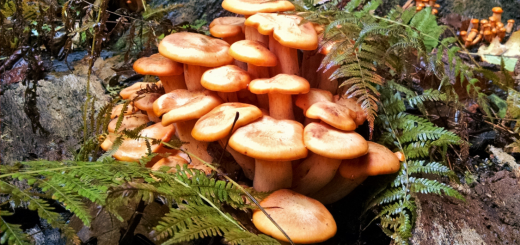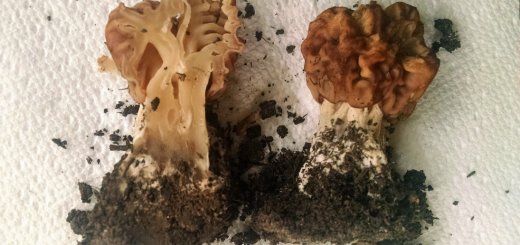#097: Ibotenic Acid and Muscimol
These two mushroom toxins impact the central nervous system and result in symptoms akin to alcohol intoxication. They are the primary toxins in the Fly Agaric, Amanita muscaria, and are responsible for the psychoactive affects of that mushroom.
Ingestion of ibotenic acid and muscimol results in a variety of symptoms that are most similar to alcohol intoxication. Initial symptoms appear after half an hour to two hours after ingestion and include nausea and vomiting. These symptoms have not been replicated in scientific studies of ibotenic acid and muscimol, so presumably they are caused either by another, unknown toxin or by variations in individual sensitivities. Initial symptoms are followed by drunken walking or inability to walk, alteration between very active and very drowsy states, confusion, visual distortion, distractibility, mild euphoria, floating sensations, feeling of strength, retrograde amnesia, and lastly a deep, dream-filled sleep lasting roughly two hours. Full visual hallucinations occur only rarely.
Pre-adolescent children experience a different set of symptoms: a loss of motor control, muscle spasms, seizures, loss of alertness, and alteration between excited and drowsy states. Neurological changes during puberty apparently alter the way the toxins affect the brain. Adults occasionally experience seizures, but this is normally limited to cases of severe poisoning.
Ibotenic acid and muscimol share the same basic chemical structure. Ibotenic acid is also known as 2-amino-2-(3-oxo-1,2-oxazol-5-yl)acetic acid. The molecule has two main structural features: a five-carbon loop and an amino acid. The loop is composed of one oxygen atom, one nitrogen atom, and three carbon atoms, in that order. The nitrogen atom is also bound to a hydrogen atom. The first carbon atom is also double-bound to an oxygen atom. The second carbon atom is bound to a hydrogen atom and double-bound to the third carbon in the ring. The third ring carbon is also bound to an amino acid backbone. In other words, the last ring carbon is bound to another carbon, which is bound to a hydrogen atom, an amine group (NH2), and a carboxyl group (COOH). Muscimol is also known as agarin, pantharene, and 5-(aminomethyl)-1,2-oxazol-3-one and is the decarboxylated form of ibotenic acid. This means that the carboxyl group (COOH) is replaced by a hydrogen atom, but the molecule is otherwise identical to ibotenic acid. There are a number of other forms of ibotenic acid that can be found in mushrooms, but for the most part they are not present in large enough quantities to be biologically active.
Both Ibotenic acid and muscimol easily pass through the blood-brain barrier, allowing them to directly interact with the central nervous system. Ibotenic acid structurally resembles the neurotransmitter GABA, so it and its derivatives readily bind to GABA receptors. GABA is an inhibitory neurotransmitter, so ibotenic acid initially decreases brain activity, resulting in drowsiness. However, ibotenic acid out-competes GABA for binding sites and remains bound to the receptors for a longer time. Additionally, ibotenic acid stimulates the synthesis of excitatory neurotransmitters such as glutamate. These two effects eventually result in a loss of neuronal inhibition by GABA receptors, increasing brain signal “noise” and thus causing mind-altering affects and seizures.
This group of toxins has resulted in relatively few deaths. Fatalities mostly occur when people eat large quantities of Amanita muscaria or A. pantherina. The Fly Agaric has been eaten for hundreds of years in Europe and since the 1960’s in the United States as a “poor man’s hallucinogen.” It has caused more deaths in Europe than in the U.S., but in both areas the hallucinogenic affects are uncertain and the mushrooms often result in illness. Boiling does not effectively remove the toxins, so they can still cause illness after being cooked. In the U.S., most deaths from ibotenic acid and muscimol are caused by A. pantherina. This mushroom is usually eaten by people who have not properly identified their mushrooms. Luckily, most victims of ibotenic acid/muscimol poisoning fully recover. As deaths are rare, treatment focuses on alleviation of symptoms. Seizures, for example, can be easily controlled by the administration of Diazepam. Additionally, doctors may try to get rid of toxins remaining in the digestive tract by inducing vomiting or by administering activated charcoal.
See Further:
http://www.mykoweb.com/TFWNA/P-27.html
http://www.mykoweb.com/TFWNA/P-28.html
http://www.botany.hawaii.edu/faculty/wong/BOT135/Lect18.htm
http://pubchem.ncbi.nlm.nih.gov/compound/Ibotenic_acid#section=Top
http://pubchem.ncbi.nlm.nih.gov/compound/muscimol#section=Top



![#013: Characteristics of Phylum Basidiomycota [Archived]](https://www.fungusfactfriday.com/wp-content/themes/hueman/assets/front/img/thumb-medium-empty.png)





![#011: Characteristics of Kingdom Fungi [Archived]](https://www.fungusfactfriday.com/wp-content/themes/hueman/assets/front/img/thumb-small-empty.png)

1 Response
[…] psychoactive compounds in A. muscaria are ibotenic acid and muscimol (see FFF#097). Ibotenic acid activates NMDA receptors and muscimol activates GABA receptors. These two compounds […]